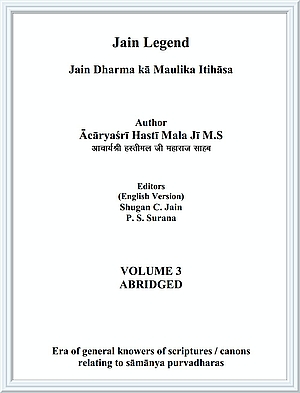| 43rd Ācārya Śrī Lakṣmīvallabha | 44th Ācārya Śrī Rāmaṛṣi Swāmī | |
| Birth | V.N.1292 | V.N.1304 |
| Initiation | V.N.1321 | V.N.1338 |
| Ācārya post | V.N.1354 | V.N.1371 |
| Death | V.N.1371 | V.N.1402 |
| Householder life | 29 years | 34 years |
| Ordinary monkhood | 33 years | 33 years |
| Ācārya hood | 17 years | 31 years |
| Total monkhood | 50 years | 64 years |
| Lifespan | 79 years | 98 years |
35th epochal-ācārya Dharmaṛṣi
| Birth | V.N.1325 |
| Initiation | V.N.1340 |
| Ordinary monkhood | V.N.1340-1360 |
| Epochal-ācārya period | V.N.1360-1400 |
| Death | V.N.1400 |
| Lifespan | 75 years 4 months 4days days |
Dharmaṛṣi He became the 35th epochal-ācārya after the death of Māḍhara Saṃbhūti. He executed the duties of an epochal-ācārya for a period of 40 years with due diligence and expertise and served the cause of Lord Mahāvīra's tradition.
Vatsarāja Gurjara Mālawarāja
During the last quarter of 13th century and first half of 14th century V.N.; a very powerful ruler, Vatsarāja ascended to the throne of Jālora. He established his dominance over the entire Avantī Empire. According to Kuvalayamālākāra Udyotana and author of Harivaṃśapurāṇa Ācārya Jina Sena, Vatsarāja was counted amongst the most powerful rulers of India during Vikram first half of 9th century. Govinda-II (Vallabha) and Dhruva sons of king Kṛṣṇa-I of Rāṣṭrakūṭa dynasty were the contemporaries of this ruler of Jālora and Mālawā Vatsarāja.
Actually the period of Vatsarāja was the same as that of the peak of Rāṣṭrakūṭa dynasty. The powerful King Dantidurga (730-753AD) of Rāṣṭrakūṭa dynasty during 730-735AD merged the entire Cālukya empire with his and created the most powerful Mānyakheṭa kingdom by defeating the Cālukya Rāja Kīrtivarmā of Bādāmī. After Dantidurga, 7th ruler Kṛṣṇa-I of Rāṣṭrakūṭa dynasty and his two sons Govinda-II and Dhruva i.e. 8th and 9th rulers of Rāṣṭrakūṭa dynasty also gradually increased the territorial empire of Rāṣṭrakūṭa dynasty.
This increase in the power of Rāṣṭrakūṭa dynasty created bad effect on Vatsarāja. Around 787AD, Rāṣṭrakūṭa dynasty ruler Dhruva launched a powerful attack on Vatsarāja. Vatsarāja was defeated in that war. Besides giving up the rule of Mālawā, Vatsarāja was forced to leave Mālawā also for shelter towards Marū Pradeśa. Seeing the outreach and power of Dhruva's army, Vatsarāja became confident that neither taking back the rule over Mālawā but his very existence in Mālawā can be a cause of his destruction. Hence Vatsarāja went to capital of Jābālipura (Jālora) in Gujarat with his remaining forces and started ruling Jālora.
A copper plate of Śaka 724 from the home Śānabhoga Narahariyappa in village Manne in Karnataka also states the defeat of Vatsarāja from Dhruva, leaving Mālawā and going towards Marūdhara Pradeśa for shelter.
Vatsarāja, after his defeat spent his remaining life in Jālora only. Vatsarāja had very friendly relations with Jain congregation.
Śakaṭāyana- Pālyakīrti
Ācārya Śakaṭāyana is counted amongst the top eight grammarians, i.e. even ahead of Pāṇinī and Amara Siṃha. The other name of Śakaṭāyana was Pālyakīrti. Ācārya Śakaṭāyana was a great ācārya and composer of religious texts belonging to Yāpanīya congregation. The following texts written by Śakaṭāyana are still available.
- Śabdānuśāsana
- Amoghavṛtti; self-commentary of Śabdānuśāsana
- Strīmukti Prakaraṇa
- Kevalīmukti Prakaraṇa.
For many centuries, Śabdānuśāsana by Śakaṭāyana was a very popular grammar text in whole of India. Besides self-commentary Amoghavṛtti (self-commentary of Śabdānuśāsana by Pālyakīrti), six other commentaries have been written on it, namely,
- Śākaṭāyana Nyāsa
- Cintāmaṇi Laghīyasīṭīkā
- Maṇi Prakāśikā
- Prakriyā saṃgraha
- Śākaṭāyanaṭīkā
- Rūpa Siddhi by Jain grammarian Amita Sāgara of Tamil in 10th century AD.
Pālyakīrti's scholarship spread far and wide. In the far off parts of India, especially entire southern India Pālyakīrti was known as King of complete knowledge and eminent grammarian throughout India.
Pālyakīrti wrote the self-commentary Amoghavṛtti in Śaka 772.
 Acharya Hasti Mala
Acharya Hasti Mala
